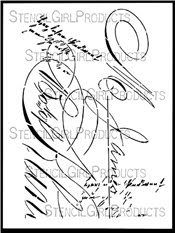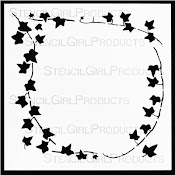StencilGirl Talk: Mary Beth Shaw's VLOG: March 2022
-
StencilGirl Talk: Mary Beth Shaw's VLOG: March 2022: Join Mary Beth in
Amsterdam and Paris! Click here for more information and registration!
skip to main |
skip to sidebar

9"X12" Stencil

Note: White vase was made with a homemade stencil.
T-SHIRTS AND MUCH MORE
To order my designs as wall art, home décor, greeting cards, phone cases or T-shirts, click here...
http://pixels.com/artists/1+cecilia+swatton
On the opening page, click on any design, and this list of merchandise choices will appear on the right.
Or use the link at the bottom of the widget below:
Translate
IVY 9

9"X12" Stencil
My Blog List
-
-
A Day of Play - I decided I needed to drag out all my mixed media supplies, starting with a bag of vintage ephemera to design some fun journal pages. I have been so foc...
-
Blog Archive
-
▼
2020
(102)
-
▼
February
(22)
- ATC MIXUP 1's DIAGONAL MANIA Used WITH 9" X 12" Ma...
- Something for Everyone in ATC Size
- Exciting Ways with ATC 9" x 12" Sheets, Continued
- More About My New ATC MIXUP SWATTON #1 and ATC MIX...
- 9" x 12" ATC MIXUP SWATTON # 1 and ATC MIXUP SWATT...
- Something for Everyone in ATC MIXUP SWATTON #1 and...
- Interference Paint with ATC MIXUP 1--SWATTON and A...
- Up, Up and Away with ATC MIXUP SWATTON #1 and ATC ...
- Embossing Paper with Stencils & Masks! Step-by-st...
- Rubbings as Art -- Wet or Dry, but Today's Focus i...
- Let's Make Jewelry with ATC-Sized Stencil and Mask...
- Idea for Launching a New Project with my two 9" x ...
- More Fun Ways to Play with my New 9" x 12" ATC MIX...
- Part 2 Pairing ATC-sized Stencils and Masks with T...
- ATC-Sized Stencils and Masks Paired with Their Big...
- Two New ATC Sheets -- Each 9" x 12" with 9 Images ...
- Brand New ATC 9" x 12" Stencils and Masks Used in ...
- Two 9" x 12" ATC Sheets of Stencils and Masks--Ava...
- 2 Unique New ATC 9" x 18" Sheets Released Today!
- Valentines of Less Traditional Colors
- Approaching Valentine's Day ... and Exploring Sour...
- Valentine Lovebirds and Sources for Materials Need...
-
▼
February
(22)
Art made withTWO VASES 9"X12" stencil

Note: White vase was made with a homemade stencil.
Search This Blog to find descriptions of techniques used to create my artwork samples...
StencilGirlProducts...
...sells my entire stencil collection here:
http://www.stencilgirlproducts.com/stencils-cecilia-swatton-s/1832.htm
http://www.stencilgirlproducts.com/stencils-cecilia-swatton-s/1832.htm


















































































